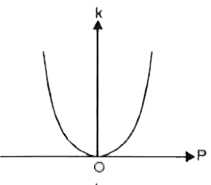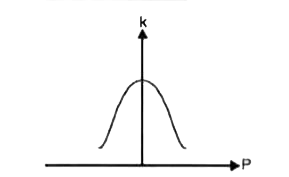If P represents linear momentum , K represents kinetic energy and T temperature, then quantities remaining constant in collision are
P,K and T
P only
K and T
T only
The correct Answer is:B
To solve the question regarding which quantities remain constant in a collision, we will analyze the concepts of linear momentum, kinetic energy, and temperature in the context of collisions.
1. Understanding Collisions:
- In physics, collisions can be classified into two main types: elastic and inelastic. In elastic collisions, both momentum and kinetic energy are conserved. In inelastic collisions, momentum is conserved, but kinetic energy is not.
2. Linear Momentum (P):
- Linear momentum is defined as the product of mass and velocity (P = mv). In a closed system where no external forces act, the total linear momentum before the collision is equal to the total linear momentum after the collision. Therefore, linear momentum is conserved in both elastic and inelastic collisions.
3. Kinetic Energy (K):
- Kinetic energy is given by the formula K = (1/2)mv². In elastic collisions, kinetic energy is conserved. However, in inelastic collisions, some kinetic energy is transformed into other forms of energy (like heat or sound), meaning kinetic energy is not conserved.
4. Temperature (T):
- During a collision, especially inelastic collisions, some of the kinetic energy is converted into thermal energy, which can increase the temperature of the colliding bodies. Therefore, temperature is not conserved in a collision.
5. Conclusion:
- From the analysis, we conclude that in a collision, the quantity that remains constant is linear momentum (P). Kinetic energy (K) is not conserved, and temperature (T) generally increases due to the conversion of kinetic energy to thermal energy.
Final Answer:
The quantity remaining constant in a collision is linear momentum (P).
- In physics, collisions can be classified into two main types: elastic and inelastic. In elastic collisions, both momentum and kinetic energy are conserved. In inelastic collisions, momentum is conserved, but kinetic energy is not.
- Linear momentum is defined as the product of mass and velocity (P = mv). In a closed system where no external forces act, the total linear momentum before the collision is equal to the total linear momentum after the collision. Therefore, linear momentum is conserved in both elastic and inelastic collisions.
- Kinetic energy is given by the formula K = (1/2)mv². In elastic collisions, kinetic energy is conserved. However, in inelastic collisions, some kinetic energy is transformed into other forms of energy (like heat or sound), meaning kinetic energy is not conserved.
- During a collision, especially inelastic collisions, some of the kinetic energy is converted into thermal energy, which can increase the temperature of the colliding bodies. Therefore, temperature is not conserved in a collision.
- From the analysis, we conclude that in a collision, the quantity that remains constant is linear momentum (P). Kinetic energy (K) is not conserved, and temperature (T) generally increases due to the conversion of kinetic energy to thermal energy.
The quantity remaining constant in a collision is linear momentum (P).
Topper's Solved these Questions
- WORK, ENERGY AND POWER Book:MODERN PUBLICATIONChapter:WORK, ENERGY AND POWER Exercise:Objective Type Questions (B. Multiple Choice Questions)
Explore 46 Videos
- WORK, ENERGY AND POWER Book:MODERN PUBLICATIONChapter:WORK, ENERGY AND POWER Exercise:Objective Type Questions (JEE (Main) & Other State Boards for Engineering Entrance)
Explore 31 Videos
- WORK, ENERGY AND POWER Book:MODERN PUBLICATIONChapter:WORK, ENERGY AND POWER Exercise:Revision Exercise (Numerical Problems)
Explore 23 Videos
- WAVESBook:MODERN PUBLICATIONChapter:WAVESExercise:CHAPTER PRACTICE TEST
Explore 14 Videos
Similar Questions
Knowledge Check
If p and E represent linear momentum and kinetic energy respectively, then the graph between E and pis correctly shown by
A B
B C
C D
D
If linear momentum if increased by 50% then kinetic energy will be increased by
A0.5B1C1.25D0.25The graph between linear monentum (p) and Kinetic energy (k) is best represented by
A B
B C
C D
D
If linear momentum if increased by 50% then kinetic energy will be increased by
View SolutionIf the linear momentum is increased by 50%, then kinetic energy will be increased by
View SolutionAssertion: If linear momentum of a particle is constant, then its angular momentum about any point will also remain constant.
Reason: Linear momentum remains constant if Fnet=0 and angular momentum remains constant if τnet=0
View SolutionIf L, M and P are the angular momentum, mass and linear momentum of a particle respectively, which of the following represents the kinetic energy of the particle when the particle rotates in a circle of radius R?
View SolutionThe graph which represents the variation of mean kinetic energy of moleules with temperature ∘C is ?
View Solution


